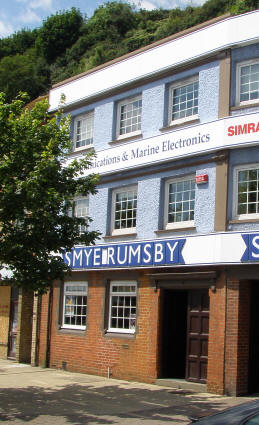| |

|
Another Roman Catholic Chapel was
built in Snargate Street in 1905/6 and was dedicated to Our Lady and St
Martin by the Bishop of Southwark on 29th March 1906.The new church, at 123 Snargate
Street, was just down the road from where Mass had been said nearly 100
years earlier at the start of the Dover mission.
It was hewn out of the cliff and built
to resemble the style of the Roman catacombs; rather plain and without
windows (although windows were added to the front).
The first incumbent was Fr. Kirwan,
in 1906. He was followed, later that year, by Fr. William Thompson,
who handed over to Fr. M. G. Gifkins in 1911. He retired in 1936 and
died 4 years later. Fr. R. E. Florance, curate of St Paul's, said
mass here for the next four years.
The church closed in 1940 and the
building remained empty before being sold in 1960.
The picture (left) shows the building
today, only slightly altered.
(awaiting old picture) |
| |
The original chapel
dedicated to Our Lady of Pity was on a headland to the west of the town,
known as Archcliffe Point.
"Great Street, which is a very short
thoroughfare, filling the space between Bulwark Street and Beach Street,
is on a rather higher level. On the headland overlooking this
spot, existed an ancient chapel dedicated to 'Our Lady of Pity.'
This chapel was supposed to have been erected in Mediaeval times by a
Northern nobleman, who was saved from shipwreck near this place; and it
was restored, in 1530, by Joachim de Vaux, the then French Ambassador to
England, who had also had an escape from sea peril on the adjoining
shore; and, after its restoration, it seems the Ambassador established
in it a friar named John de Ponte. This ecclesiastic was accused
of giving information to the French, during the war in 1538, by burning
lights in his chapel during the night. This not only brought him
into trouble with the Government, but also made him so unpopular with
the Dover people that the arms of the King of France, placed over the
chapel door, were defaced. When Sir John Clark, the Master of the
Maison Dieu, and the originator of Paradise harbour, died, this Friar
applied to the King's Remembrancer for the place, but without success,
for the appointment went to Sir John Thompson, rector of St. James's,
who retaliated on his rival, breaking into his chapel, and reporting to
the King that he found in the Mass book the Pope's name before the
King's. Eventually, the Mayor of Dover imprisoned John de Ponte
for communicating intelligence to the French; and, during his
incarceration, his chapel was desecrated. It was then annexed by
the Dover fishermen, and, in 1576, was totally destroyed by a tempest."
(JBJ, 1907)
"The Graves" - the area reputed to have been the
burial place for the victims of the plague in 1666, may have been attached
to this chapel.
The dedication to Our Lady of Pity was continued in
1960, when a new church was opened in the newly established Catholic
parish of Buckland. Three years later another new church, dedicated
to St. Martin, was opened at Aycliffe.
|
